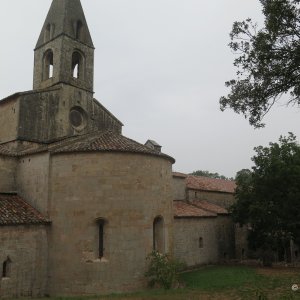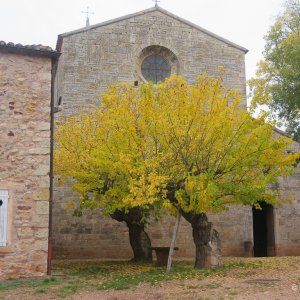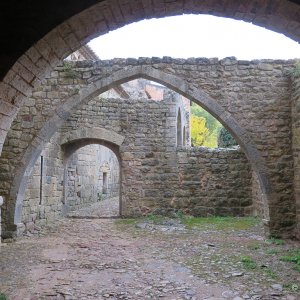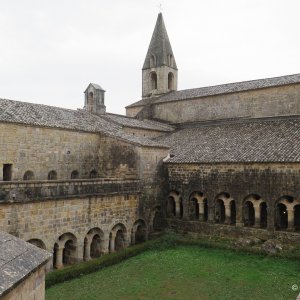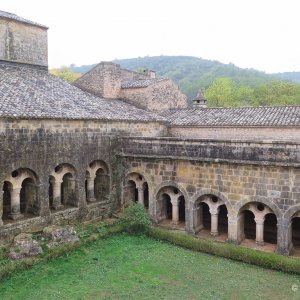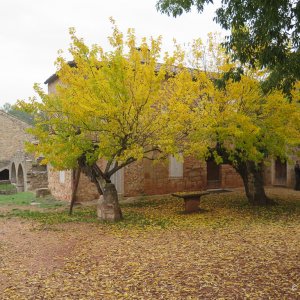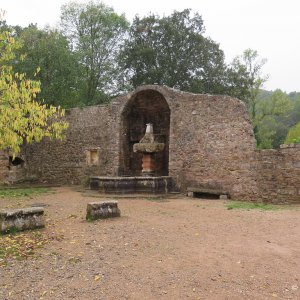There is so much to see in Provence if you’re a history buff, it could drive you crazy. In order to preserve our sanity and marriage, The Husband and I decided to follow a theme on this trip to Provence, and restrain ourselves to visiting Roman sites. We also agreed to throw in visits to three Cistercian abbeys because they were on the way to other sites we wanted to see anyway, and I have a thing about cloisters and we both love medieval architecture. As it turned out, the Three Sisters, as these abbeys in Provence are called, were a major highlight of the trip. Even though places such as the Pont de Gard, Vaison la Romaine, Orange, Arles and Nimes were impressive, these austerely beautiful abbeys made us catch our breaths. We could not have imagined such simplicity and spiritual beauty built in stone.
A little background on our trip – we had gone to attend a friend’s wedding in Aix-en-Provence, and while he and his new wife were honeymooning in Bali, we had the use of their house. This meant that we day tripped wherever we could, and if we had to stay overnight someplace in order to really see a city, it didn’t break the budget.
The abbeys of Silvacane and Senanque are a nice day trip from Aix, and it’s a wonderful trip driving through the Luberon where you can see those lovely little villages perched on the hills and eat at outdoor cafes with the locals. We passed the towns of Bonnieux and Gordes, towards the town of Cadenet and arrived at l’Abbay de Silvacane, the Abbey of the Reeds, by the banks of the Durance River.
Abbaye de Silvacane
Location: France - Provence - Bouches-du-Rhone - La Roque-d'Anthéron
Silvacane Abbey is located north of Aix-en-Provence off the road to Cadenet and Lourmarin.
Website: Abbaye Silvacane
Built in 1174, this is the most recent of the Three Sisters, known as the “Abbey of the Reeds”. When the monks first settled here, they had to drain swamps before they could build the abbey and grow crops, hence the reference to reeds. The architectural style is known as Provencal Cistercian Romanesque, a “transitional” style that incorporates a few elements of the Gothic. The Gothic-style cathedrals made it to Provence much later than in the north, so many of the later buildings look Romanesque even though they were built when Gothic was sweeping the rest of France.
 The Cistercian orders were the first to consciously practice what we call “form follows function” in architecture: simple, functional, stripped of any ornamentation that would take the mind away from prayer. Their philosophy was to avoid excess in any form and practice poverty, simplicity and seclusion (the seclusion part still works, we had a tough time finding signs to the abbey). Hence, the simple beauty of their buildings, where the stone was left bare both inside and out, with only simple carvings for decoration. Very few flying buttresses were needed since the monks did not strive to build for height or ostentation. The resulting effect is that you focus on the purity of the architecture, the elegance of the naves, the wonderful proportions of the spaces, the way light travels between openings. What moved us was the serenity that suffuses all areas of the abbey, both inside and out.
The Cistercian orders were the first to consciously practice what we call “form follows function” in architecture: simple, functional, stripped of any ornamentation that would take the mind away from prayer. Their philosophy was to avoid excess in any form and practice poverty, simplicity and seclusion (the seclusion part still works, we had a tough time finding signs to the abbey). Hence, the simple beauty of their buildings, where the stone was left bare both inside and out, with only simple carvings for decoration. Very few flying buttresses were needed since the monks did not strive to build for height or ostentation. The resulting effect is that you focus on the purity of the architecture, the elegance of the naves, the wonderful proportions of the spaces, the way light travels between openings. What moved us was the serenity that suffuses all areas of the abbey, both inside and out.
The Cistercians also standardized on their buildings, and all Cistercian abbeys followed the same basic floor plan. Kind of the way some fast food franchises build to the same design.
I think the rooms that gave me the most pause for thought were the library, refectory and the chapter house. The library was tiny! This is because books were so expensive back then, and that really made me feel fortunate to live in a time where mass printing makes knowledge so affordable. The chapter house and refectory were where the monks congregated and ate together, and it really gave you a sense of the sort of communal living that they aimed for.
And let’s not forget the cloisters. The cloister gardens are planted with cedar trees, boxwood and white roses. Serenity, serenity, serenity.
At all Cistercian abbeys, the monks tried to be self-sufficient, buying land to grow crops and raise animals. Each abbey was essentially a farming estate, with orchards, stables, and fields that were worked by lay brothers and hired workers. The Cistercian order was founded by Bernard of Clairvaux. Incidentally, Bernard clashed with Abelard, of Heloise and Abelard fame. He later got to be St. Bernard (and all Abelard got to be was castrated). Bernard was very critical of the corrupt monasteries of the time, hence very insistent on that the Cistercian order embrace poverty and simplicity. Unfortunately, the Cistercians became so successful at running their agrarian estates that they went from self-sufficient to prosperous to downright decadent over the space of a few hundred years, and by the 14th century became just as disreputable as other orders. This story kind of repeats in all the abbeys we visited.
The abbey was restored in 1945. Prior to this, the abandoned buildings had been used as stables, storage and whatever else the various owners felt like doing.
Abbaye de Senanque
Location: France - Provence - Vaucluse - Gordes
Website: Abbaye Notre Dame de Sénanque
Then we headed back north of Silvacane towards Senanque, near Gordes. If you can, go to Senanque in summertime when the lavender is in bloom. The final mile of road to Senanque sweeps down the side of the valley with the abbey below to your left, surrounded by lavender fields. It’s enough to make you swoon with pleasure.
 Unfortunately getting to Senanque when the lavender is in bloom also means being there when tourist season booms. Somewhat less serenity, but still amazingly beautiful.
Unfortunately getting to Senanque when the lavender is in bloom also means being there when tourist season booms. Somewhat less serenity, but still amazingly beautiful.
Built in 1148 (then it prospered, over-prospered, monks were expelled, abbey was abandoned etc.) Senanque is now once again a working monastery. The monks re-settled here in 1988 and in the interests of self-sufficiency they embarked upon an additional form of economic endeavor. There is a gift shop (staffed by non-monks) selling lavender and honey products from the abbey, as well as beautiful books about Cistercian architecture, history and religion.
My husband, who is a civil engineer by training, went into raptures over the four squinches (look this up yourself, what do I know about squinches) that hold up the cupola of the dome in the church. I headed for the cloisters.
It’s interesting to see how the basic floor plan was shifted around to accommodate the geography. Because Senanque is in a narrow valley, the church faces north rather than east.
On the way back to Aix, we made a small diversion to Apt, to see the Pont Julien. It’s not the Pont de Gard, it’s not magnificent, it’s just a little 3rd century bridge built by the Romans, but it’s still carrying road traffic (for vehicles under 5 tons). That in itself is amazing. My husband scrambled down to the riverbed to look at the bridge foundations, and concluded that one of the arches of the bridge had been partially built, then moved a few feet over to get the alignment right (have I mentioned the civil engineering bit?).
Abbaye du Thoronet
Location: France - Provence - Var - Le Thoronet
Thoronet Abbey is north of the main autoroute that goes from the Cote-d'Azur to Aix-en-Provence. It can be visited from Aix or as a day trip from the Cote d'Azur (an hour's drive from Nice). There is a large parking lot, with a short walk to the abbey. The historic part of the abbey is open to visitors. Visit the church, the cloisters, the chapter house, the converts building, and the storeroom. There is a large gift shop. The monks chant every Sunday at noon.
Website: Abbaye du Thoronet
This is another day trip from Aix. This abbey is close to the town of Le Thoronet, and was built around 1140 (obviously the 12th century was a good time to be a stonemason near a Cistercian abbey).
 We had a magical few minutes in this abbey when we went into the church. There were three backpackers standing there looking around, your usual young guys in hiking shorts and t-shirts. Then they broke into beautiful plainsong and the acoustics of the church carried the music and it was sublime. We closed our eyes and imagined ourselves back in the 13th century, listening to monks at evensong.
We had a magical few minutes in this abbey when we went into the church. There were three backpackers standing there looking around, your usual young guys in hiking shorts and t-shirts. Then they broke into beautiful plainsong and the acoustics of the church carried the music and it was sublime. We closed our eyes and imagined ourselves back in the 13th century, listening to monks at evensong.
In the photo of the exterior of the abbey, you can see a niche in the wall. This was so that the locals could bring their dead to the abbey. The corpse would be placed into the niche to ask the monks to prepare the body for burial and organize the funeral services.
Of all the three abbeys, I found this one the most interesting because there are ongoing excavations of the monastic buildings and also of the outbuildings that housed workers, animals, and food storage. It really gives you a sense of how the monks conducted their lives. Also, you were allowed to climb up to the second level of the buildings and above the cloisters to look down into the courtyard below.
In Closing
Photographs don’t do these abbeys justice, especially since the interiors are hard to photograph (flashbulbs don’t give enough light in some places). Neither do words. You can only understand the impact of these buildings by standing in one. And I guess you have to really love medieval architecture. I am not at all a spiritual person, but the abbeys were a near-religious experience, perhaps even better than the seafood risotto on the island of Burano near Venice or Ben & Jerry’s Cherry Garcia ice cream after two months of being on the South Beach Diet.
As a final note of interest, the newest Cistercian monastery was built in 2004 in the Czech Republic. The architect is minimalist John Pawson, who was also responsible for the Calvin Klein store in New York. Apparently the monks were looking through books of architecture and were struck by how the austerity of the retail store paralleled their requirements for a new monastery.
Google Map
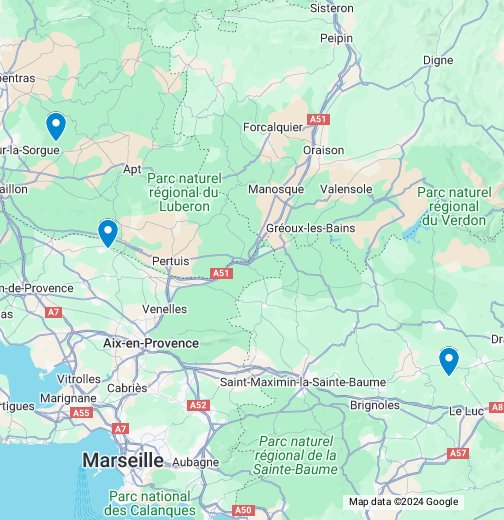
More Photos
Photos from Pauline's 2016 visit.
Janie Chang has been a part of this community since 2005, when she first joined the Slow Travel forum. Janie used to be an active member of the forum and faithfully wrote about her trips, but it’s been a lot tougher to find the time since she became a published author of two novels about pre-war China. She has lived in Taiwan, the Philippines, Iran, Thailand, and New Zealand. She lives in beautiful Vancouver, Canada with her husband and a cat who thinks the staff could be doing a better job. Her author website is: www.janiechang.com.
A little background on our trip – we had gone to attend a friend’s wedding in Aix-en-Provence, and while he and his new wife were honeymooning in Bali, we had the use of their house. This meant that we day tripped wherever we could, and if we had to stay overnight someplace in order to really see a city, it didn’t break the budget.
The abbeys of Silvacane and Senanque are a nice day trip from Aix, and it’s a wonderful trip driving through the Luberon where you can see those lovely little villages perched on the hills and eat at outdoor cafes with the locals. We passed the towns of Bonnieux and Gordes, towards the town of Cadenet and arrived at l’Abbay de Silvacane, the Abbey of the Reeds, by the banks of the Durance River.
Abbaye de Silvacane
Location: France - Provence - Bouches-du-Rhone - La Roque-d'Anthéron
Silvacane Abbey is located north of Aix-en-Provence off the road to Cadenet and Lourmarin.
Website: Abbaye Silvacane
Built in 1174, this is the most recent of the Three Sisters, known as the “Abbey of the Reeds”. When the monks first settled here, they had to drain swamps before they could build the abbey and grow crops, hence the reference to reeds. The architectural style is known as Provencal Cistercian Romanesque, a “transitional” style that incorporates a few elements of the Gothic. The Gothic-style cathedrals made it to Provence much later than in the north, so many of the later buildings look Romanesque even though they were built when Gothic was sweeping the rest of France.
The Cistercians also standardized on their buildings, and all Cistercian abbeys followed the same basic floor plan. Kind of the way some fast food franchises build to the same design.
I think the rooms that gave me the most pause for thought were the library, refectory and the chapter house. The library was tiny! This is because books were so expensive back then, and that really made me feel fortunate to live in a time where mass printing makes knowledge so affordable. The chapter house and refectory were where the monks congregated and ate together, and it really gave you a sense of the sort of communal living that they aimed for.
And let’s not forget the cloisters. The cloister gardens are planted with cedar trees, boxwood and white roses. Serenity, serenity, serenity.
At all Cistercian abbeys, the monks tried to be self-sufficient, buying land to grow crops and raise animals. Each abbey was essentially a farming estate, with orchards, stables, and fields that were worked by lay brothers and hired workers. The Cistercian order was founded by Bernard of Clairvaux. Incidentally, Bernard clashed with Abelard, of Heloise and Abelard fame. He later got to be St. Bernard (and all Abelard got to be was castrated). Bernard was very critical of the corrupt monasteries of the time, hence very insistent on that the Cistercian order embrace poverty and simplicity. Unfortunately, the Cistercians became so successful at running their agrarian estates that they went from self-sufficient to prosperous to downright decadent over the space of a few hundred years, and by the 14th century became just as disreputable as other orders. This story kind of repeats in all the abbeys we visited.
The abbey was restored in 1945. Prior to this, the abandoned buildings had been used as stables, storage and whatever else the various owners felt like doing.
Abbaye de Senanque
Location: France - Provence - Vaucluse - Gordes
Website: Abbaye Notre Dame de Sénanque
Then we headed back north of Silvacane towards Senanque, near Gordes. If you can, go to Senanque in summertime when the lavender is in bloom. The final mile of road to Senanque sweeps down the side of the valley with the abbey below to your left, surrounded by lavender fields. It’s enough to make you swoon with pleasure.
Built in 1148 (then it prospered, over-prospered, monks were expelled, abbey was abandoned etc.) Senanque is now once again a working monastery. The monks re-settled here in 1988 and in the interests of self-sufficiency they embarked upon an additional form of economic endeavor. There is a gift shop (staffed by non-monks) selling lavender and honey products from the abbey, as well as beautiful books about Cistercian architecture, history and religion.
My husband, who is a civil engineer by training, went into raptures over the four squinches (look this up yourself, what do I know about squinches) that hold up the cupola of the dome in the church. I headed for the cloisters.
It’s interesting to see how the basic floor plan was shifted around to accommodate the geography. Because Senanque is in a narrow valley, the church faces north rather than east.
On the way back to Aix, we made a small diversion to Apt, to see the Pont Julien. It’s not the Pont de Gard, it’s not magnificent, it’s just a little 3rd century bridge built by the Romans, but it’s still carrying road traffic (for vehicles under 5 tons). That in itself is amazing. My husband scrambled down to the riverbed to look at the bridge foundations, and concluded that one of the arches of the bridge had been partially built, then moved a few feet over to get the alignment right (have I mentioned the civil engineering bit?).
Abbaye du Thoronet
Location: France - Provence - Var - Le Thoronet
Thoronet Abbey is north of the main autoroute that goes from the Cote-d'Azur to Aix-en-Provence. It can be visited from Aix or as a day trip from the Cote d'Azur (an hour's drive from Nice). There is a large parking lot, with a short walk to the abbey. The historic part of the abbey is open to visitors. Visit the church, the cloisters, the chapter house, the converts building, and the storeroom. There is a large gift shop. The monks chant every Sunday at noon.
Website: Abbaye du Thoronet
This is another day trip from Aix. This abbey is close to the town of Le Thoronet, and was built around 1140 (obviously the 12th century was a good time to be a stonemason near a Cistercian abbey).
In the photo of the exterior of the abbey, you can see a niche in the wall. This was so that the locals could bring their dead to the abbey. The corpse would be placed into the niche to ask the monks to prepare the body for burial and organize the funeral services.
Of all the three abbeys, I found this one the most interesting because there are ongoing excavations of the monastic buildings and also of the outbuildings that housed workers, animals, and food storage. It really gives you a sense of how the monks conducted their lives. Also, you were allowed to climb up to the second level of the buildings and above the cloisters to look down into the courtyard below.
In Closing
Photographs don’t do these abbeys justice, especially since the interiors are hard to photograph (flashbulbs don’t give enough light in some places). Neither do words. You can only understand the impact of these buildings by standing in one. And I guess you have to really love medieval architecture. I am not at all a spiritual person, but the abbeys were a near-religious experience, perhaps even better than the seafood risotto on the island of Burano near Venice or Ben & Jerry’s Cherry Garcia ice cream after two months of being on the South Beach Diet.
As a final note of interest, the newest Cistercian monastery was built in 2004 in the Czech Republic. The architect is minimalist John Pawson, who was also responsible for the Calvin Klein store in New York. Apparently the monks were looking through books of architecture and were struck by how the austerity of the retail store paralleled their requirements for a new monastery.
Google Map
More Photos
Photos from Pauline's 2016 visit.
Provence, Thoronet Abbey
- Pauline
- 12
Thoronet Abbey (Abbaye du Thoronet) is a Cistercian abbey founded in 1146. It is one of the...
Janie Chang has been a part of this community since 2005, when she first joined the Slow Travel forum. Janie used to be an active member of the forum and faithfully wrote about her trips, but it’s been a lot tougher to find the time since she became a published author of two novels about pre-war China. She has lived in Taiwan, the Philippines, Iran, Thailand, and New Zealand. She lives in beautiful Vancouver, Canada with her husband and a cat who thinks the staff could be doing a better job. Her author website is: www.janiechang.com.
Last edited by a moderator:

